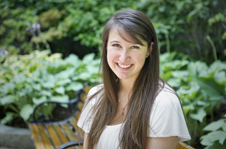‘Transforming suffering into blessing’

Northeastern University student Emili Kaufman has been selected to receive the 2011–2012 Gideon Klein Award to study the artwork of German surrealist painter Felix Nussbaum, who died in the Nazi concentration camp at Auschwitz in 1944.
The award — which includes a $5,000 prize — honors the memory of Gideon Klein, a brilliant Czech pianist and composer who died in a Nazi death camp in January 1945. Northeastern distinguished professor of chemistry Bill Giessen, who grew up in Nazi Germany and passed away in 2010, established the award in 1997 in memory of his mother, Gustel Cormann Giessen.
For Kaufman, winning the award carries a considerable amount of personal significance. Her father, a Jewish professor of illustration, recently passed away.
“By winning this award, I feel like I will be able to honor my father as well as those who were persecuted in the Holocaust,” said Kaufman, a senior communication studies major with a minor in Jewish studies.
Lori Lefkovitz, Ruderman Professor and director of the Jewish studies program, was a member of the selection committee that chose Kaufman. Lefkovitz said Kaufman’s proposal was particularly heartfelt and sincere.
“She studies art and Jewish studies partly to sustain the memory of her own father,” Lefkovitz said. “This poignant confluence of memorializing testifies to Northeastern’s ongoing commitment to creatively incorporate the past into the future, transforming suffering into blessing through art and scholarship.”
As part of her project, Kaufman plans to conduct research on Nussbaum’s body of work and create an artistic tribute to the painter under the guidance of art professor Mira Cantor. Kaufman will present her findings and her artwork during Northeastern’s Holocaust Awareness Week, in March 2012.
According to Kaufman, Nussbaum communicated his fear of being captured by the Nazis through two famous paintings — “Self Portrait with Jewish Identity Card” and “Triumph of Death”— that he created while in hiding. Shortly after, Nussbaum was discovered by German armed forces, sent to Auschwitz and murdered.
“He’s interesting because he went through phases like Picasso,” Kaufman said. “Based on the colors he used, you could tell when he was happy or when he was sad.”
After graduating next spring, Kaufman would like to work in a fundraising capacity for the Jewish Museum in New York City. “I’m driven by the incredible history of Judaism,” she said. “I think their story says a lot about humanity and what people are capable of doing.”




